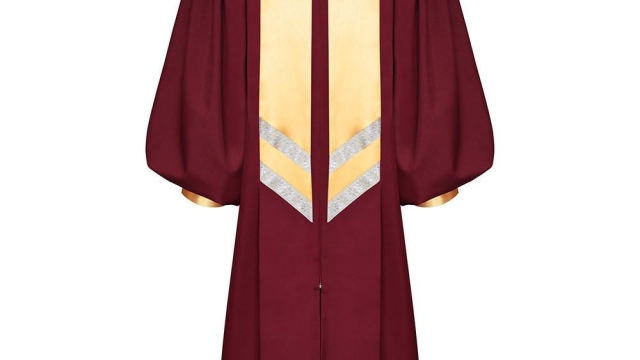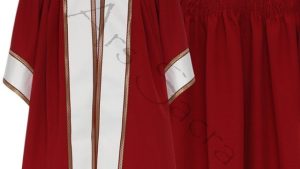
Harmony in Attire: Exploring the Elegance of Choir Robes

Choir robes have long been an integral part of choral performances, adding a touch of elegance and harmony to the overall presentation. These dignified and timeless garments not only serve a practical purpose but also have symbolic meaning within the choral community.
When one envisions a choir standing together in their robes, a sense of unity emerges. Regardless of age or background, the robes create a visual cohesion that brings the individual voices together as a collective force. The dignified appearance evokes a sense of purpose and professionalism, as the singers present themselves as ambassadors of song.
Moreover, choir robes have a rich history that dates back centuries. They serve as a link to the past, connecting today’s singers with the long-standing tradition of choral music. The robes have evolved over time, adapting to the changing styles and preferences of different eras, but their essence remains unchanged – to enhance the beauty of the music and elevate the performance.
It is not just the visual appeal, but also the practicality of choir robes that contributes to their significance. These garments are designed to facilitate movement while also creating a sense of anonymity, allowing the focus to remain on the music rather than individual performers. This anonymity fosters a sense of equality among choir members, reminding them that their voices are part of a greater whole.
In conclusion, choir robes serve both practical and symbolic purposes within the choral community. They bring singers together, honoring tradition, and paving the way for a harmonious and graceful performance. So next time you find yourself immersed in the enchanting sound of a choir, take a moment to appreciate the elegance and significance of their attires – for in harmony, there lies beauty.
The Historical Significance of Choir Robes
Choir robes have a rich history that dates back centuries. These elegant garments have been an integral part of choral music traditions, symbolizing unity, reverence, and tradition. Choir robes not only enhance the aesthetics of a performance but also carry profound historical significance.
Choir robes first came into prominence during the medieval period. In those times, choral music was highly sacred and performed exclusively in religious settings. The robes worn by the choir members served as a visual representation of their role as messengers of divinity. The flowing designs and regal colors of the robes symbolized purity, humility, and spirituality.
Childrens Choir Robes
During the Renaissance, choir robes became even more elaborate and stylized. Intricate embroidery and ornate details adorned the garments, reflecting the growing importance of choral music as an art form. The robes became a canvas for intricate craftsmanship, showcasing the skills of talented artisans who worked tirelessly to create breathtaking designs.
In addition to their religious significance, choir robes also played a practical role. In earlier times, many vocalists came from different social classes, leading to a visual disparity among choir members. The uniformity of choir robes helped to bridge this gap, uniting individuals from diverse backgrounds under a common purpose. This sense of unity fostered a harmonious atmosphere and allowed the focus to shift to the collective effort of creating beautiful music.
The historical journey of choir robes reflects the evolution and transformation of choral music as a whole. These attire have transcended time, preserving the traditions and values associated with choral performances throughout history. Today, choir robes continue to be an essential element of choir performances, reminding us of the enduring power and grace of this timeless art form.
The Functional Benefits of Choir Robes
Choir robes serve a multitude of functional purposes that go beyond their traditional visual appeal. Designed specifically for choral performances, these elegant garments offer several key benefits that enhance both the performance experience and the overall harmony of the ensemble.
First and foremost, choir robes provide a sense of unity among the singers. By wearing matching robes, choir members are able to present a cohesive image to the audience, symbolizing their collective effort and dedication. This visual uniformity helps to create a sense of teamwork and cooperation, allowing the focus to be on the music rather than individual appearances.
Additionally, choir robes offer practical advantages during performances. Made from high-quality fabrics, they are designed to ensure freedom of movement. With their loose and flowing silhouettes, these robes enable singers to move and breathe comfortably while performing complex vocal arrangements. This freedom of movement is essential for delivering powerful and expressive performances, allowing the choir to fully engage with the music.
Furthermore, choir robes contribute to the acoustic quality of the performance. The loose-fitting nature of the robes helps to reduce unwanted microphones and sound reflections, ensuring optimal sound projection and resonance. The robes also act as a barrier between the body and the singers’ surroundings, minimizing any potential distractions and allowing the voices to blend harmoniously.
In conclusion, choir robes offer more than just aesthetic appeal. They provide a sense of unity, comfort, and enhanced acoustics for choral performances. By understanding and appreciating the functional benefits of these elegant garments, we can truly explore the harmony they bring to the world of choir music.
The Symbolic Meaning of Choir Robes
Choir robes hold a deep symbolic meaning within the world of choral music. Their elegant presence enhances not only the visual appeal of the choir but also represents unity, tradition, and devotion to the art of singing. These robes have become an iconic symbol of choral ensembles globally, carrying a rich history that dates back centuries.
The first aspect to note is the unity that choir robes bring to a vocal group. By adorning themselves in identical attire, singers are symbolically transformed into a collective entity rather than a group of individuals. It is a visual representation of their commitment to each other and to the harmonious music they produce. The robes, regardless of style or color, serve as a unifying force that highlights the power of collaboration and teamwork in creating breathtaking musical performances.
In addition to unity, choir robes also embody a sense of tradition. Rooted in religious ceremonies, these robes date back to medieval times when choirs were an integral part of church services. The act of wearing robes during performances has been passed down through generations, preserving a link to the past and paying homage to the historical significance of choral music. The presence of choir robes showcases the enduring nature of this art form and its continued relevance in modern times.
Furthermore, choir robes signify the devotion and seriousness with which singers approach their craft. While the robes may vary in design and embellishment, their purpose remains the same – to elevate the music and create an atmosphere of reverence. When singers don their robes, they step into a role that demands discipline, focus, and dedication. The act of putting on the robe becomes a ritualistic way of mentally and emotionally preparing for a performance, channeling the collective energy of the choir into a unified expression of musical excellence.
In conclusion, choir robes hold a powerful symbolic meaning in the world of choral music. They represent unity, tradition, and devotion to the art of singing. Through their presence, we witness the coming together of individual voices to form a harmonious whole, carrying on a legacy that goes far beyond the fabric they are made of. Choir robes are not mere garments; they are a visual representation of the beauty and elegance that can be achieved when voices blend in perfect harmony.

